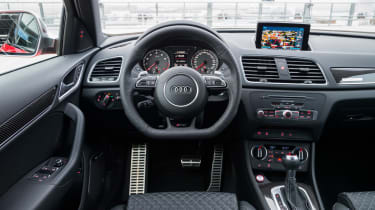Audi RS Q3 2015 review
Audi gives high-performance RS Q3 a make-over. But is it enough to tempt more buyers to part with their cash?

The RS Q3 is an example of Audi pushing the envelope in what’s possible. It’s a very niche car and one that has attracted under 500 sales in the UK since its release last year. Audi believes this overhaul will add some punch, but we believe it still remains an expensive oddball.
For a good while, the Audi RS Q3 strode a lonely path. Before the car’s arrival last year, no one had really thought the class of the high-performance compact SUV existed. But just like you’d expect from the all-conquering German giant, Audi gave the sector a bash and did what some thought impossible – it handed over its Q3 to its quattro division and created a red-hot SUV.
And yet, despite the arrival of Mercedes’ GLA 45 AMG which offered up some healthy competition, the RS Q3’s sales performance hasn’t been as dramatic as its styling would suggest. Audi would say 443 units for such a niche product is fair game, but it’s hardly the type of sales number we’ve come to expect from the firm. Can a facelift, improved efficiency and, more importantly a power increase interest more UK buyers to delve into their pockets and hand over around £45,000?
Used - available now

2022 Peugeot
E-2008
17,336 milesAutomaticElectric
Cash £13,400
2021 Peugeot
2008
9,432 milesManualPetrol1.2L
Cash £15,100
2023 Jaguar
I-PACE
23,066 milesAutomaticElectric
Cash £21,697
2024 Kia
Stonic
18,073 milesAutomaticPetrol1.0L
Cash £15,002Just like its comparatively run-of-the-mill Q3 brother, the new RS Q3’s facelift mainly focuses on the front. There’s now, what Audi likes to describe as, a ‘3D-effect Singleframe’ grille that houses a honeycomb grille – traditional Audi RS fare. Also typically RS is the large air vents complete with even more honeycomb, while new LED headlights also feature.
To the rear the taillights are very slightly different – the biggest change is the addition of ‘scrolling’ indicators – the indicator scrolls from the inside to the outside of the lamp cluster in the direction in which the car is turning.
But those are just cosmetic details – the big feature of the RS Q3 has always been the engine and the new model gets a tweaked motor. While other manufacturers are turning their backs on five-cylinders for environmental reasons, Audi is embracing its characterful 2.5-litre five-pot and has not only added more power but also made it more economical to boot.
The engine is now Euro 6-compliant and with it sweeps in a power upgrade of 30bhp (bringing the total output to 335bhp), a 30Nm boost, and a half-second drop for the 0-62mph sprint time: the high-riding car gets up to the benchmark time in 4.8 seconds, partly thanks to improved shift times from the standard seven-speed S tronic gearbox. Combined economy has also been bumped up with the RS Q3 returning 32.8mpg while CO2 emissions have dropped to 203g/km.
It’s a tremendously flexible engine, providing low-speed refinement and a proper turn of speed once the throttle is prodded, but the crowning glory is the noise – the five-pot howls all the way to 7,000rpm and delivers smile-inducing pops and crackles through the exhaust.
However, while the engine delivers, the driving experience doesn’t impress like some other RS models. The steering is just plain numb in ‘comfort’ mode, while prodding the ‘dynamic’ setting just weights it up and firms up the suspension – another area where the RS Q3 lets itself down. While a jiggly ride is familiar in RS models, it’s at odds with the supposed useability a fast SUV offers and there’s plenty of understeer if you push it on country roads.
Newcomers to the RS Q3 will be amazed at the car’s abilities though. The car’s turn of speed is of the type you wouldn’t expect from a pumped-up family car, and the quattro system provides superb traction. It’s not the last word in precision but for those who want the kudos of an RS badge but love the practicalities so inherent to the Q3, the car is appealing in a strange sort of way. It’s an expensive oddball but it’s easy to see the appeal.










